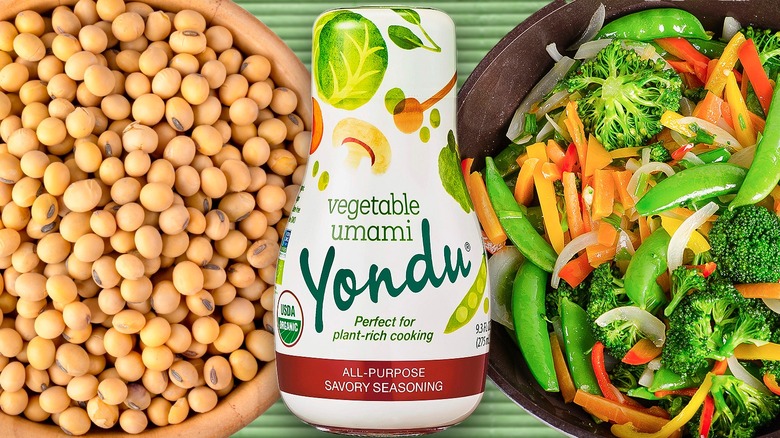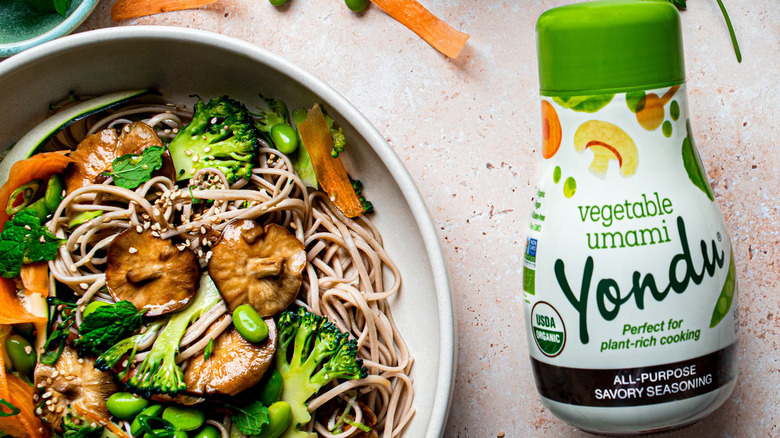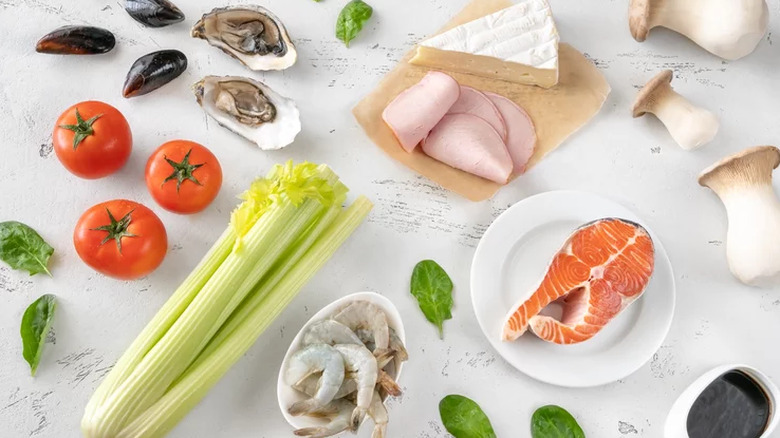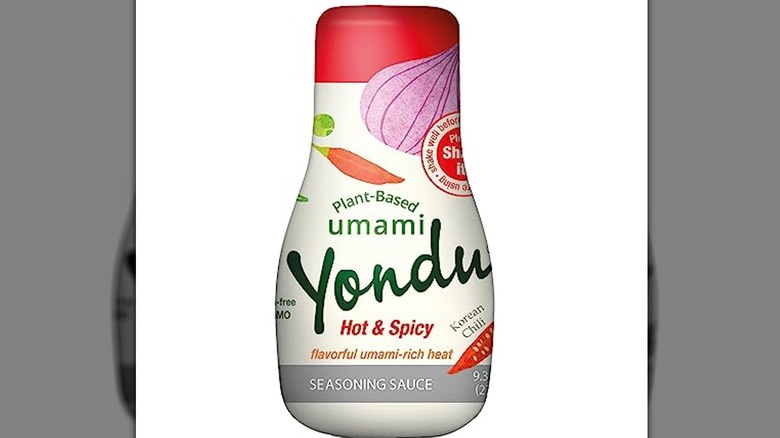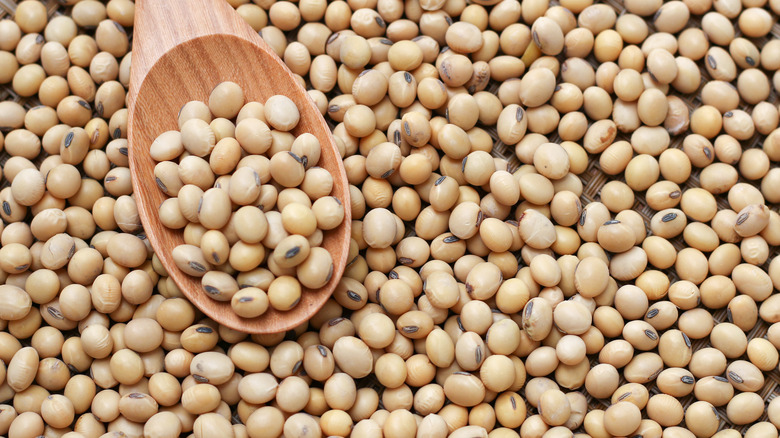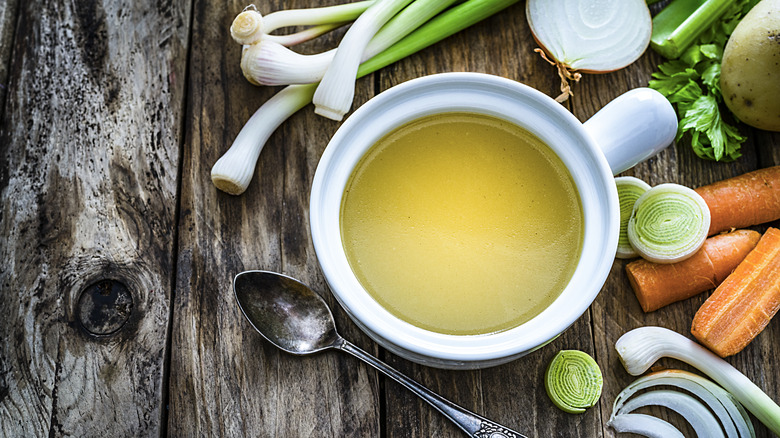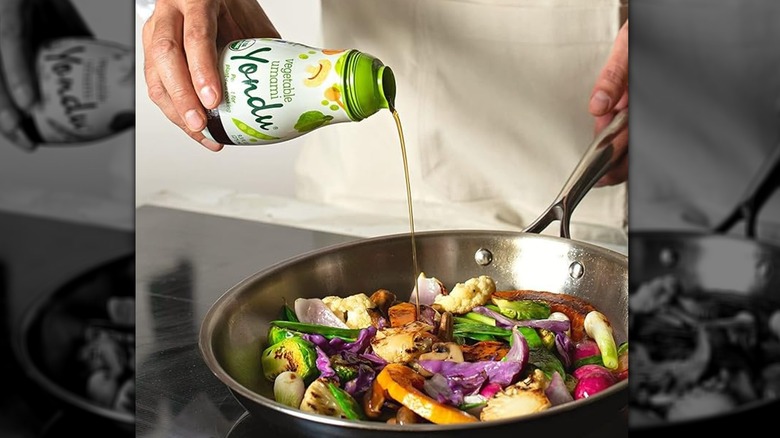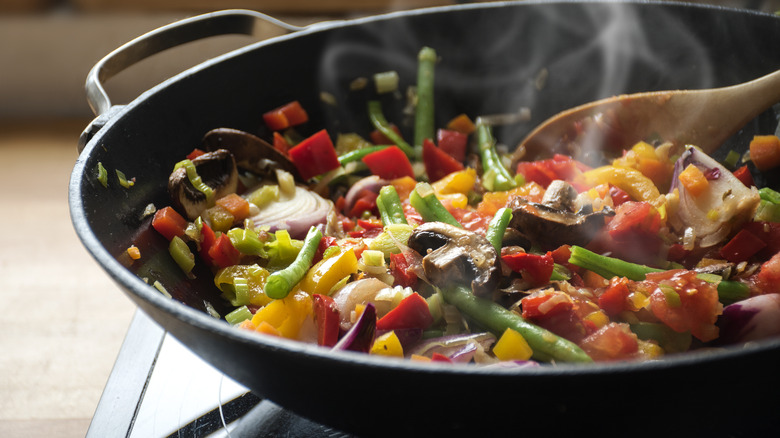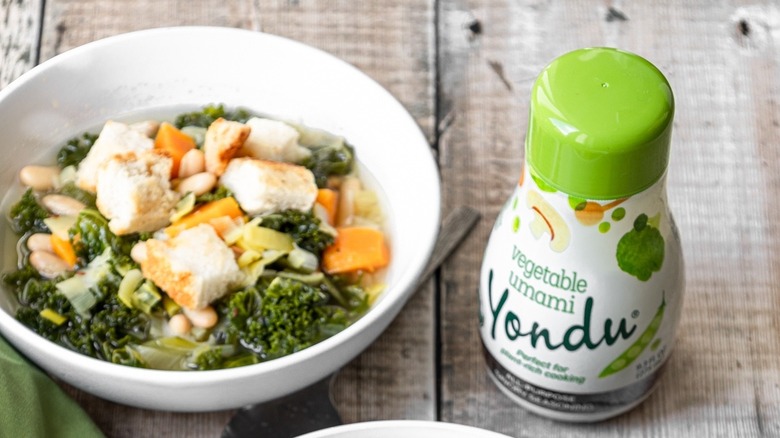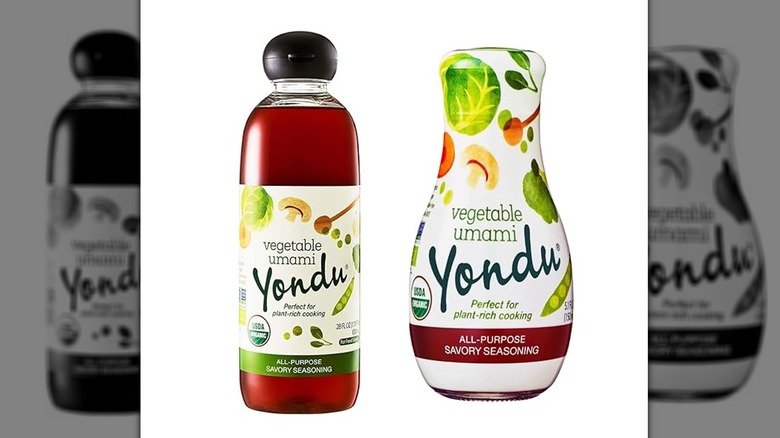Yondu Is The Savory Seasoning You Need For Your Vegetables
We may receive a commission on purchases made from links.
In recent years, there's been buzz around a relatively new product called Yondu, an umami seasoning that can proudly sit alongside other pantry classics like soy sauce and bouillon. It's been a hit with vegans and vegetarians as it adds the complex savoriness that something like fish sauce does, while being completely plant-based. Yondu isn't only for plant-based eaters however, it's so easy to use and adds incredible flavor to anything you're cooking, that it's a useful all-purpose seasoning for every type of home cook.
I'm a recipe developer and food business owner, and Yondu is a grocery staple for me. I came across it at a specialty Korean food store in my city and have made it part of my regular cooking ever since. Its versatility is unmatched as it can be used cold in a salad dressing, or cooked into something like soup, and you can just as easily use it in an Italian dish as you could in a Korean dish.
Yondu has been hailed by numerous chefs like José Andrés and chef Junghyun Park, and it's even an integral part of how Momofuku prepares its decadent truffle ramen. It's especially good with vegetables which taste great even if you only use Yondu on them and nothing else. Yondu adds a delicious seasoning that doesn't overpower the natural flavor of your veggies, but rather helps them to be their best selves.
What is Yondu?
Yondu is a seasoning condiment you use for adding extra umami to your cooking. It's made by one of the oldest registered Korean brands, called Sempio, which specializes in fermented food products that are essential for Korean cooking. Yondu is a type of concentrated soup essence, and you can think of it as something similar to soy sauce, bouillon, oyster sauce, or fish sauce. However, it's completely plant-based, making it the perfect fish sauce substitute for vegetarians and vegans that are looking for that flavor depth. It's not a sauce in the conventional sense, as you wouldn't have Yondu on its own, but it does add more oomph to your savory dishes.
When making soup, it takes a while for that comforting, deep soup flavor to develop, unless you reach for a stock cube to help strengthen it. Yondu steps up to the task, and it will instantly make a flavorful vegetarian broth that can rival any stock cube. Plus, it goes beyond being a broth enhancer; there are countless ways to cook with it and as a seasoning, it doesn't overpower food the way soy sauce, aminos, and fish sauce can do. Yondu is a little more subtle, making your ingredients shine, rather than masking their flavor.
What is umami?
It's likely that you've already heard the word umami and know of its importance in great tasting food. If you haven't, this must all be very confusing! There's some misconception that the term is synonymous with being salty, since many umami rich foods have brined notes, like sardines and cured meats, for example.
However, there is a difference between umami and salty as fundamental tastes; umami means something like "savory" or "meatiness." It's recognized as one of the five elements of flavor that we experience along with salty, sour, bitter, and sweet. You can add more salt to a dish, and doing so wouldn't increase the umami in it in any way. Umami doesn't need salt to taste savory, just like a tomato can taste savory on its own, or taste salty when you add salt to it.
Interestingly, the scientific origins of umami (the word) come from the 1900s, before which it was accepted that there were only four tastes: salty, sweet, sour, and bitter. A Japanese chemist named Kikunae Ikeda recognized a different taste when he ate dashi (a type of seaweed and bonito flake broth) and found that it was because of something named glutamic acid.
The compound is also found in other foods like cheese, tomatoes, meat, and mushrooms. He named it umami, but it wasn't until the 2000s, when his work was translated to English, that the rest of the world became familiar with the concept of a fifth taste.
What's in Yondu?
We've established that Yondu is totally plant-based and has a powerful umami flavor. For many flavor enhancing products there can be a worry of the kinds of ingredients that are going towards making it taste good. People often assume that's the role of artificial flavors and that they'll be added in. This isn't the case with Yondu.
Instead, Yondu is made from organic soybeans, water, salt, and a concentrated vegetable stock and a yeast extract. The components of the stock include carrots, shiitake mushrooms, celery, cabbage, ginger, white radish, and alliums like garlic, onion, and leek. Basically, all the vegetables you might add to make the most delicious vegetable stock at home.
In certain stores, you might find a spicy version of Yondu for people who love hot food. Notice the difference on the bottle of a red chili pepper design, and a red lid. This spicy Yondu contains all the ingredients in the original, plus the addition of spicy elements like Korean chili peppers and spicy chili pepper seasoning.
How is Yondu made?
There's always a lot of mystery about how our favorite products get made. The process can be fascinating to learn about and sometimes it's simpler than we think. It appears that Yondu's process is pretty simple but uses high-quality ingredients and time to develop the complex and balanced flavor of the product.
According to Yondu's website, this umami sauce is made by blending two key components. The soybean extract and the concentrated vegetable broth. For the soybean extract, non-GMO and organic soybeans are slowly fermented in three stages to develop that deep savory taste. These three stages are seed malt fermentation, lactic-acid fermentation, and yeast fermentation. For this process, only three ingredients are used, namely soybeans, sea salt, and water. The fermentation takes place over the course of 100 days. This is then blended with a broth that's been boiled down and concentrated, made from a selection of vegetables and alliums.
How does Yondu taste?
Yondu's taste is a little tricky to describe — it's not a flavor that's comparable to other sauces. It has very mild notes of miso and shiitake if you taste it completely on its own. It is slightly salty, but balanced and without any overarching aroma. The closest thing it could remind you of is a really vegetable rich broth that's been cooking for hours (which is essentially what it is).
Once you cook with Yondu, it can be almost impossible to isolate its flavor as it doesn't stick out. Rather, it adds umami to your food without adding intensity. This may sound vague, but it will make sense when you try it, and is part of what makes it stand out in comparison to other umami-packed condiments that have very distinct and recognizable flavors. Only, Yondu comes without the downside of being too dominant or overpowering.
What are the benefits of using Yondu?
There are so many products that enhance umami in your cooking. Yondu offers many benefits that it can sometimes be the best choice compared to other seasonings and sauces. First, it's completely plant-based, so you get all the umami goodness without the need for fish or oyster sauce, chicken stock, bouillon, or other non-vegan products.
It's also made from all natural products only and uses no preservatives. You may be thinking that this sounds like soy sauce, or even a vegetarian bouillon or stock cube, and why move from using something you're already familiar with? Well, unlike many of these products, Yondu is naturally gluten-free. Additionally, it's made from non-GMO and USDA certified organic soybeans, something that isn't always guaranteed with soy sauce (or gluten-free alternatives like liquid aminos or tamari).
Yondu is also wonderful to use as an all-purpose seasoning. It helps you to simplify your cooking as you don't need to have multiple ingredients to season and flavor your food. In fact, you can use just Yondu on some sautéed or roasted veggies and there's no need to add any salt.
How to use Yondu?
Yondu can be implemented at any stage of cooking, or used in no-cook situations, too. For many people, one of the most obvious uses is soup or broth-based dishes. Without Yondu, you may spend a couple hours simmering produce to make an umami vegetable stock; with Yondu, you simply add a splash to water for the same effect.
Keep in mind, you only need a little bit of Yondu to benefit from added umami. Use a ratio of two teaspoons of Yondu to one cup of water to make a basic broth, then proceed as usual with your cooking. Yondu doesn't have to function as a substitute if you still prefer to make your own stock or broth. You can simply add Yondu in to amplify the flavor more.
If you're making sautéed vegetables, use one teaspoon of Yondu to two cups of veggies, and in my experience, add it before cooking or after as a finish. It's also good for roasted veggies before or after they enter the oven, especially in combination with other sauces or seasonings you love.
Yondu can even be used when cooking beans, grains, or pasta. Pour Yondu straight into the water you cook your rice with; the same applies to other grains. It adds a new, bolstering dimension to pasta sauce. Whatever your grain or carb, use one teaspoon of Yondu to two cups of cooked ingredients. One final suggestion? Use Yondu in a vinaigrette or salad dressing. In my experience, 1 teaspoon mixed into a quarter cup of vinaigrette composed of olive oil, balsamic vinegar, salt, and herbs, produces an incredible dressing for a green salad.
The best way to use Yondu for your vegetables?
Once you start cooking your veggies with Yondu, you'll realize just how versatile an ingredient it is. There is no best way to use it, and it all depends on your preference for how you like to eat your vegetables. To get you started and to really see how Yondu works, I recommend cooking a single vegetable with Yondu.
When I'm using only one vegetable, I like using zucchini chunks or green beans. I sauté them in a drizzle of olive oil over medium heat for between five and 10 minutes depending on how hardy the vegetable is. As they're busy cooking, I add in a couple of drops of Yondu. It enhances a vegetable's own great taste without being too saline or potent.
Pour a few drops of Yondu into your pan or wok when making a veggie stir fry. Yondu can even be part of a dipping sauce for a vegetable platter, or mix it in with your other favorite condiments to make an umami-packed sauce for some cold noodles.
When using Yondu on raw veggies like in a chopped salad or slaw, you should always mix it into the other liquids you're using as a dressing. This will enhance its ability to evenly coat your veggies, and you can taste it before to see if you need more. Always start with a little bit and increase, rather than adding too much, as Yondu is a concentrated liquid and a little goes a long way.
Can you use Yondu with meat dishes too?
Yondu is an attractive product for vegetarian cooking because it's totally plant-based, but that doesn't mean it can't be used with meat dishes, too. In fact, Yondu is a great way to reinforce the umami that develops from caramelized meat.
It's a useful addition to marinades for anything from pork chops to chicken thighs or beef steaks. The best part is that it doesn't matter if you're grilling, barbecuing, braising, or roasting your meat, Yondu lends variety and seasoning to your marinade without requiring any other ingredients.
And it functions in tandem with other sauces, such as alongside barbecue or a sweet chile sauce. You can even use Yondu in combination with soy or fish sauce if you love either flavor. Yondu works with them to boost the umami and balance out the flavors.
It might not need saying, but Yondu can be added to a broth for any type of soup, from creamy chicken soup to slow-cooked beef noodle soup. It can also be mixed into curry sauces, and stews. You can even add a teaspoon or 2 into your ragu for spaghetti Bolognese, or add it into your pesto for a chicken pesto panini.
What is Yondu's mission?
What's clear from the marketing behind Yondu is a move to eating and cooking in a way that's better for people and the environment. Simply, it appears that Yondu was created to encourage more home cooking, eating more vegetables and even decreasing the need for salt and other unnecessary additions. Moreover, it shortens your cooking time, because you don't need to take the time to develop the flavor of your soup or sauce when Yondu can instantly do that. That time can be spent connecting with loved ones or preparing other foods. The shorter cooking time also encourages cooking at home instead of ordering take out.
Its parent company, Sempio, is a staple of Korean cuisine; a cuisine that is highly centered around vegetables and fermented foods. Korea is among the highest vegetable consumers in the world, and Sempio is to "study and share this culture with anyone who cares about food," per its website.
Nutritional information and storage
Yondu isn't a nutrient-rich food, and you shouldn't be looking for it to add anything nutritious to your diet. It is purely a flavor enhancer and contains zero calories. A regular, 9-fluid-ounce bottle of Yondu contains about 55 servings, and a teaspoon qualifies as one serving. Yondu contains zero carbohydrates, protein, or fat. One serving contains 350 milligrams of sodium, which is 15% of your recommended daily intake.
Yondu is a shelf-stable product, and it can stay in your pantry without the need for being refrigerated, even after opening. However, it is recommended that you keep it refrigerated if you plan to use it sparingly and over a long period of time to slow down the natural darkening and aging of the product.
Where to buy it?
You can't find Yondu in mainstream grocery chains yet, however it is sold in select specialty grocery stores and Asian markets across the mid-Atlantic and Pacific Northwest, as in New York, Maryland, Delaware, New Jersey, Washington D.C., Pennsylvania, Oregon, California, Virginia, Hawaii, and Vermont. You can check the Yondu website for specific locations.
You can also order it online at Amazon Prime, Walmart, or other big box retailers. If you're interested in buying Yondu in bulk, you can order directly from the Yondu website.
